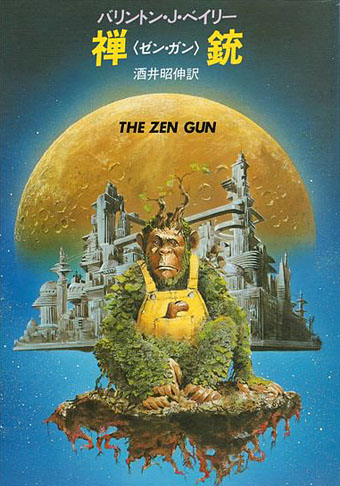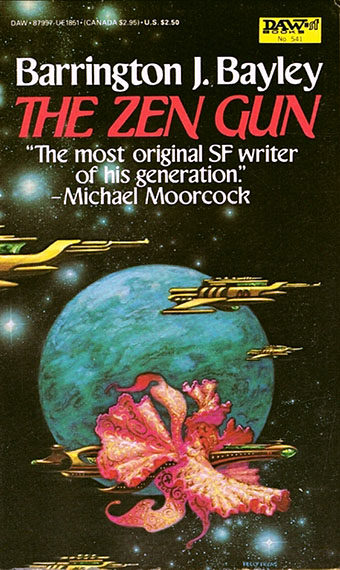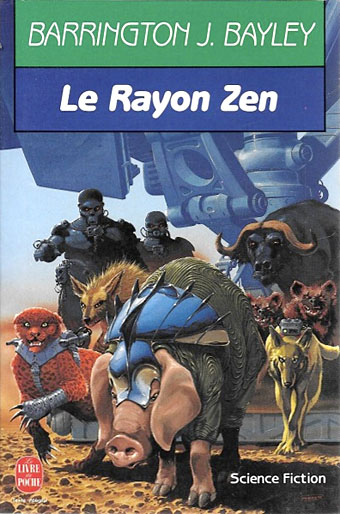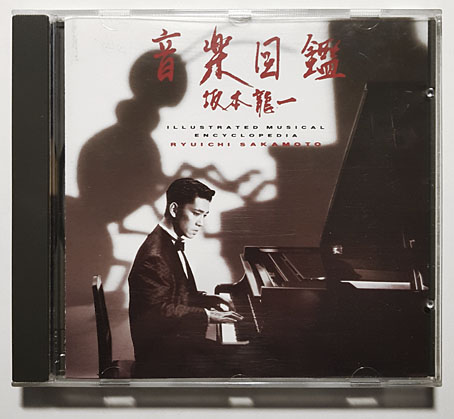
Japanese edition, 1984. Cover artist unknown.
At last, kosho Hako Ikematsu permitted himself to exult, at last he held the zen gun in his hands.
Zen in the art of electronics…
He knew its age: more than three Earth centuries. He knew its provenance: the zen master who made it had been a member of the order from which his own had originally sprung. The external appearance of the gun was a testament to certain cultural concepts: it seemed improvised, unfinished, crude, yet in its lack of polish was a feeling of supreme skill…in the Nipponese language of the time it had wabi, the quality of artless simplicity, the rustic quality of leaves strewn on a path, of a gate mended roughly with a nailed-on piece of wood and yet whose repair was a quiet triumph of adequacy and conscious balance. It had shibusa, the merit of imperfection. Only incompleteness could express the infinite, could convey the essence of reality. Hence, the unvarnished wood bore the marks of the carver’s chisel…
These qualities were themselves but superficial excrescences of the principles on which the gun acted, principles so abstruse in character that one dictum alone succeeded in hinting at them: Nothing moves. Where would it go? Pout the chimera had succeeded in using the gun as an electric beam to hurt or kill, without regard to location. But that was the most trivial of its capabilities. Only a kosho could unlock its real, dreadful purpose…
I read a novel recently that was unapologetic space opera. This isn’t something I do very often. Ryuichi Sakamoto is to blame, strange as this may seem, as a result of my spending a day or two listening to my old Sakamoto CDs. One of these, Illustrated Musical Encyclopedia, contains a short instrumental titled Zen-Gun, a piece which almost shares a title with the space opera in question, The Zen Gun by Barrington J. Bayley. I bought the Sakamoto disc in 1990, and I’ve known about the novel, which was published in 1983, for almost as long as I’ve been listening to the album. Every now and then I’ve wondered whether the two works might be connected, or at least whether Sakamoto borrowed Bayley’s title, but I’d never considered reading the novel until now.

US edition, 1983. Cover art by Kelly Freas.
Barrington Bayley (1937–2008) is a writer whose works I’d mostly avoided while he was alive. This despite the continual praise he received from Michael Moorcock, and the acknowledgement by William Burroughs in Nova Express for an idea borrowed from a Bayley story with a Burroughs-like title, The Star Virus. (Samples of Burroughs’ voice happen to turn up on an album that Ryuichi Sakamoto recorded after Illustrated Musical Encyclopedia, the Bill Laswell-produced Neo Geo. Make of this what you will.) Bayley was the odd man out among the British writers of science fiction’s New Wave for persevering with hard SF, a sub-genre I don’t enjoy reading very much unless it’s by a trustworthy writer. All genres have their share of bad writers but science fiction, especially the variety concerned with space-faring and futuristic technology, has historically been home to more than most. I already knew that Bayley could write a decent story—he appeared regularly in the pages of New Worlds magazine—but I feel I’ve been doing him a disservice by ignoring his novels for so long.
The thing that really pushed me towards The Zen Gun was reading the Wikipedia entry for the novel which includes the following praise from Bruce Sterling:
Yet Bayley’s elemental energy, his mastery of the sense of wonder, cannot be denied. His work is the very antithesis of tired hackdom. To invent an entire self-consistent cosmology and physics for a $2.50 DAW paperback…is one of those noble acts of selfless altruism that keep SF alive.
Then there’s this comment about the mysterious Zen Gun itself, a piece of wood carved into the shape of a pistol which is capable of destroying entire suns: “Powerful as the weapon is, its existence is a paradox, as only those who have attained inner peace can use it.” After reading this I knew I had to read the novel.

French edition, 1991. Cover art by Manchu.
The Zen Gun is a short book fizzing with energy enough to sustain a much longer novel. Two other recent reads may give an idea of its flavour. Last year I paid a return visit to Alfred Bester’s Tiger! Tiger! (aka The Stars My Destination), and Bayley shares with Bester an audacious imagination that fills a modest amount of pages with a wealth of ideas. Brian Aldiss referred to space opera presented in this manner as “widescreen baroque”. Bayley isn’t really exuberant enough to fully qualify for the widescreen label but he’s almost there; 16:9 rather than the full 2.35:1. His invention verges on the comic when you have massive starships piloted by pigs, a detail that suggests both George Orwell and The Muppets, as though Bayley had seen the “Pigs in Space” sketch and thought “Yeah, why not?” Most of Earth’s mammals in this novel have had their intelligence increased so they can help out the human beings, albeit as second-class citizens. There’s an interstellar empire but it’s sparsely populated—humans are more interested in pleasure than breeding—and somebody (or something) has to keep the place running. As a consequence of this many of the empire’s robots have been on strike for the past hundred years, insisting on similar treatment. This may sound like Douglas Adams territory but Bayley’s momentum and a wry sense of humour keep outright comedy at bay.
The other book that came to mind, and a closer match than Bester, was Moebius and Jodorowsky’s The Incal, which I’d read again just before starting The Zen Gun. Both books feature decadent aristocrats, talking animals, interplanetary conflict, a titular artefact that’s small yet all-powerful, plus a diverse cast of characters thrown together by chaotic, galaxy-spanning events. Jodorowsky’s super-warrior, the Metabaron, has an equivalent in Bayley’s space-age samurai, Hako Ikematsu, the only character in the novel who understands the true nature of the Zen Gun. Jodorowsky’s core concern always comes down to metaphysics, however, whereas physics without the meta- is what interests Bayley. One of the problems facing all writers of space opera is how to justify moving those spaceships from one star to the next in a Universe constrained by the speed of light. The simplest thing is to either ignore the issue or explain it away with some pseudo-scientific hand-waving. Bayley does rather more than this, proposing a counterintuitive explanation for the way that gravity works (it’s a repulsive rather than an attractive force) in order to make faster-than-light travel feasible. This may be more pseudo-science but the details require elaboration so he has a computer deliver a “Basic Physics” lecture to a character being held captive in a mobile city. There’s further elaboration in a lengthy afterword at the end of the novel; Bayley took this stuff seriously. He even manages to connect his theories to the Zen koan quoted in the novel, “Nothing moves. Where would it go?” As Bruce Sterling says, this is effort beyond the call of duty for a cheap SF paperback.

I enjoyed the novel, then, but what about the connection between Bayley’s book and Sakamoto’s music? Sakamoto’s album was released in Japan in 1984 bearing the title Ongaku Zukan (literally “Musical Picture Book”). The album had eleven tracks but none of these were named Zen-Gun. When the album was released internationally in 1986 the number of tracks had been reduced to eight, one of which was a new song, Field Work, recorded with Thomas Dolby. The final piece on the Japanese release, Ma Mère L’oie, was now renamed Zen-Gun, the only track from the original album to be given a new title. This is a better fit for the music if you know that Ma Mère L’oie is the French name for Mother Goose, as well as the title of a suite of short piano pieces composed by Maurice Ravel. Sakamoto would be familiar with the Ravel from his classical training but his instrumental sounds typically Japanese, nothing like Ravel’s music. We’re left to guess the relevance of all these connections, and also the reason for the title change, but the timing was right for Sakamoto to have seen Bayley’s book somewhere even if he never actually read it. Several of Bayley’s novels have been published in Japan, with The Zen Gun appearing there the same year that Ongaku Zukan was released. Musicians have to call their compositions something, and titles can come from anywhere. (The aforementioned Bill Laswell often seems to rifle through his William Burroughs books when he needs a title.) Whatever the reasons behind the title change—and I’m happy for this to remain a mystery—I enjoy the connection all the more now I’ve read the novel.
• Further reading: Annihilation Factotum: The work of Barrington J. Bayley by Rhys Hughes.
Previously on { feuilleton }
• Emshwiller illustrates Bester

Thank you for highlighting this now little-known SF classic. You’ve perfectly enumerated the reasons that it grabbed me in my youth and has continued to hold my attention all these years later.
Garments Of Caean was inspiration for a popular anime and I’ve heard Bayley did quite well in japan, but I’ve also heard he had publishers ripping him off, so I wonder how much of that success made it to his bank account? I’d hardly call it a revival but I’ve certainly seen a recent increase in discussion of Bayley.
Thanks, Robert. It wouldn’t be the first time an author was more popular in a foreign country than he was at home. I’m pleased to discover this, even if he didn’t get paid properly. Mike Moorcock often seemed to be trying in vain to interest people in Bayley’s fiction.